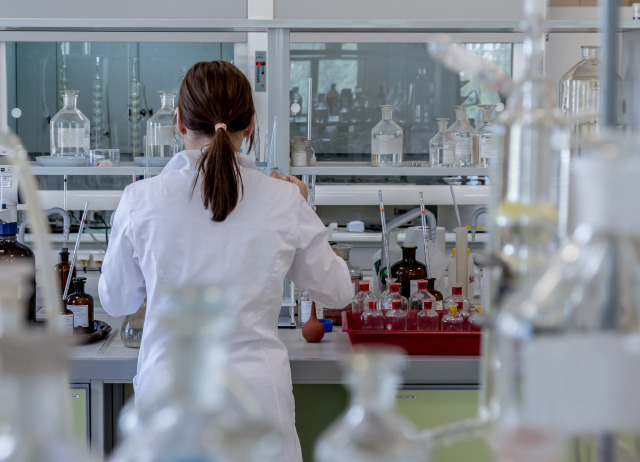Mass Spectrometry
Mass Spectrometry is a powerful and highly sensitive instrumental analysis technique, which consists of (1) the ionization of molecules, (2) the separation of the ions produced in an analyzer with a vacuum system and (3) their detection according to their mass/charge ratio (m/z).
This technique can be applied to both qualitative and quantitative analysis of organic and inorganic compounds of low and high molecular weight, being especially powerful when coupled to a previous separation technique such as chromatography.
In its qualitative aspect, mass spectrometry provides us with the necessary tools for the identification of substances, both by knowing their exact mass value (elemental composition) and by fragmenting the molecule of interest into ions of lower molecular weight (structural characterization).
Regarding quantitative analysis, the ionic intensity detected can be correlated with the amount of substance present in the sample, being a relative quantification referred to the presence of reference standards in the preparation, or by performing a "label-free" analysis if fragmentation analysis is performed.
The Mass Spectrometry Service can provide technical assistance for the analysis and interpretation of the spectra obtained and practical training to the users of this technique.

Type of Analysis
There are many fields of application for this technique. The sectors that most demand this type of service are the chemical, pharmaceutical and food industries. Other fields of application in which the presence of mass spectrometry is necessary are the analysis of contaminants, toxicology, biology or biomedicine. In refineries, it is useful in the analysis of the composition and quality control of petroleum products.
The mass spectrometers that provide this service allow the detection of molecules that differ in size and shape within the same preparation, as well as the detection of molecules that are at a very low concentration level. Thanks to the coupling of previous separation systems (uHPLC and gas chromatography), the sensitivity and detection of different compounds within complex samples is increased.
Analytical application areas that benefit from the possibilities offered by the Service include all those requiring the determination of charge-mass ratios within a wide molecular weight range (20-60,000 m/z):
- Identification of metabolites.
- Identification of natural products.
- Identification of chemical synthesis products.
- Protein identification and peptide characterization.
- Identification of polymers.
- Molecular information on the spatial distribution of the analyte of interest in an animal or plant tissue.
In addition, the service has several libraries covering analytes of diverse nature: lipids, steroids, bacterial and plant metabolites, peptides, carbohydrates, drugs and exogenous metabolites, etc. It also has libraries for the identification of natural products, with information on a minimum of 200,000 molecules, generated in silico from MS/MS data or fragmentation.
The equipment of the center's Mass Spectrometry Service offers the possibility of performing different types of analysis depending on the most appropriate ionization mode:
- Electrospray (ESI) which allows the analysis of labile compounds, which in solution (with or without additives) generate charged ions. It is not possible to analyze insoluble compounds. Avoid solvents with high boiling points, such as DMSO, which are problematic in mass spectrometry.
- Atmospheric pressure chemical ionization (APCI). This ionization technique allows ionization of compounds of lower polarity and with some thermal stability.
- Matrix-assisted laser desorption ionization (MALDI) allows working with biomolecules and polar molecules. It also allows direct coupling with the mass spectrometer, generating images of the spatial distribution of a metabolite in a tissue.
- Electrospray-assisted desorption ionization (DESI). Similarly, MALDI allows the acquisition of images of the spatial distribution of an analyte, except that it does not destroy the sample.
And it has two mass spectrometers with two different analyzers, providing great versatility in the type of analysis or compounds to be studied:
- Quadrupole-Time-of-Flight (Q-TOF) with StepWave system (Waters®), which allows the analysis in positive and negative modes, of both polar and apolar samples, and of high complexity.
- Q-TOF with TriWave IMS (Waters®), maximizes ion mobility separation, allowing separation by size, shape and charge, thus enabling chemistry and structural biology studies.
Requirements
Samples shall be delivered to the service in a closed and properly labeled tube.
A sample weight of 0.1-0.5 mg is required, indicating the type of solvent necessary for total solubility.
The application form must be filled in before the service is provided.
Measurement parameters
- High resolution charge-to-mass ratio measurements with high sensitivity, at ultra-trace levels and with linearity and robustness in both targeted and non-targeted analysis with quantification.
- Allows chromatographic retention time measurements by gas chromatography (GC) and liquid chromatography (LC).
- Possibility to measure collisional cross sections (CCS) and perform separations of analytes by ion mobility, which take into account not only the charge (z) and the mass of the molecule (m), but also the shape of the molecular structure in a three-dimensional space, thus being able to solve very similar structures in some cases even isomers with the same elemental composition.
- It allows obtaining a quasi-molecular mass without fragmentation.
- Analysis of molecules of various sizes, from the smallest molecules to large polymers and proteins.
- Elucidation of the structure of organic and biological molecules.
Equipment
The Mass Spectrometry Service of the center consists of:
- Waters SYNAPT XS ion mobility Q-TOF mass spectrometer for LC/MS and LC/MSMSMS applications as well as DESI and MALDI-TOF.
- Waters VION IMS Q-TOF mass spectrometer for LC/GC-MS and LC/GC-MSMS applications.
The injection system includes the sample transport mechanism, temperature control, and injection fluidics with two micro-dosing trays, allowing the use of up to two racks in different formats with 24, 48 or 96 position plates.
Our laboratory operates under strict standards and we have a quality policy based on compliance with Good Laboratory Practices (GLP). Integrated by scientists and technicians with years of experience in the laboratory, we have the expertise to carry out the interpretation of the results, adding value to the initial analysis.
Request for analysis
To request an analysis, please contact the Laboratory, where you will be informed of the procedure to follow.
The opening hours and reception of samples are from Monday to Friday, from 9 AM to 2 PM hours.
How can I request a service?
Contact us!
info [at] ipna.csic.es (Contact us!)
